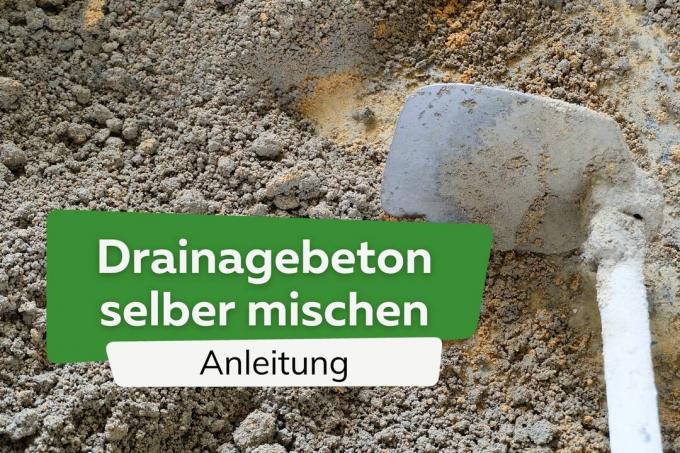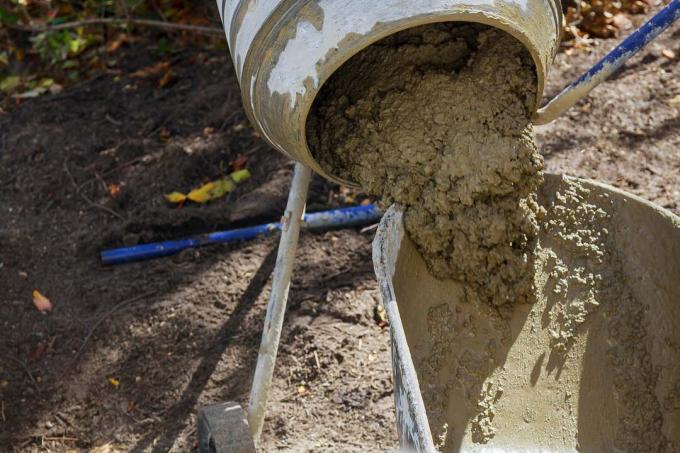
Drainage concrete is used for projects such as garden paths or paved patios due to its water-permeable properties. The special type of concrete can be mixed by yourself in order to have the desired amount available.
In a nutshell
- water permeable
- Cement-aggregate mixture without sand
- is processed earth-moist
Table of contents
- composition
- mixing ratio
- utensils and materials
- Mix drainage concrete: instructions
- frequently asked Questions
composition
Drainage concrete is a special mixture that does not require any sand at all. By not using sand, cavities are created in the mass that are water-draining. As a result, the drainage concrete can be used as a bedding or load distribution layer for paths, terraces, balconies, driveways and similar projects. If it is used as mortar for walls, possible moisture damage is prevented in the long term, especially outdoors. This is possible with the following composition:
- Portland cement (trass cement)
- Gravel, grit and other aggregates
- various additives (depending on the manufacturer)
- Water

The grain size is particularly important here so that the required cavities can form:
- at least 4 mm
- usually 6 to 22 mm
The cement paste produced during mixing ensures that the individual grains stick together firmly. In addition to water permeability, the drainage concrete also has the following properties:
- frost resistant
- prevents efflorescence
- soundproofing
- prevents ruts
- Easy to process
mixing ratio
The mixing ratio is of course essential when mixing drainage concrete yourself. Manufacturers offer drainage concrete in handy mixtures that can be easily mixed with water. With aggregate and cement, you can of course do without purchasing a ready-mix and implement it yourself. This is recommended, for example, if you have enough cement left.
The mixing ratio as follows:
- 5 parts aggregate
- 1 part cement
The mixture thus consists of 6 parts, what the Determination of the need relieved. On average you need for a cubic meter Drainage concrete a quantity of 1,850 kilograms of the materials mentioned. This is the dry bulk density before water is added. If you now convert this quantity into the six parts, you can calculate exactly how much cement and aggregate you need:
- 6 parts = 1,850 kg
- 1 part = 1,850 kg / 6
- 1 part = 308.33 kg
Now take the value and multiply it by the number of parts. For one cubic metre, it looks like this:
- 5 parts aggregate = 1,541.66 kg
- 1 part cement: 308.33 kg
utensils and materials
Compared to other types, drainage concrete is not so easy to mix yourself, since the amount of water cannot be determined exactly. For this reason it is important to use suitable materials and utensils for mixing. It doesn't matter whether you use prepackaged drainage concrete or weigh the cement and aggregate yourself.

You need:
- Bucket, bucket or wheelbarrow
- Mixing attachment for drill, hand mixer or cement mixer
- watering can or garden hose
- safety goggles
- protective gloves
- optional: long clothes
A notice: You don't have to buy equipment for mixing, you can rent it from hardware stores, private individuals or online retailers. Agitators and concrete mixers are already available for 10 to 20 euros per day.
Mix drainage concrete: instructions
- Put on the protective clothing to begin with. After adding water, the mass becomes strongly alkaline, which can cause skin irritation, allergic reactions and even chemical burns.
- Put the dry mass in the mixing container. Be careful of dusting materials, whether you bought a bag from the hardware store or made the mix yourself.
- Now add water little by little and stir until a earth-moist mass is formed. Be careful not to add too much water as drainage concrete must not be runny. Semi-dry concrete is reminiscent of moist earth in appearance and can be separated from the rest of the mass in individual lumps.
- To check the consistency, use the so-called "snowball test". To do this, take a small amount of the drainage concrete in your hand and form a ball. If the drainage concrete can be easily shaped and does not fall apart, it is suitable for processing. You can be absolutely sure with the pressure test by pressing the ball with your thumb and only then does it fall apart. If it's still too dry, add more water.
- The concrete can then be distributed and worked in with a mason's trowel or by hand.

A notice: Preferably mix smaller quantities of drainage concrete. This gives you enough time to work the concrete without it drying out.
frequently asked Questions
You have up to 90 minutes to process the drainage concrete after mixing. Because it's semi-moist, it won't dry out as quickly, but don't take too long.
Drainage concrete does not act as an adhesive like other types of concrete. In order to be able to fix paving stones or slabs on the concrete, for example, an adhesive slurry or bonding agent is necessary. It ensures that there is a firm connection between the concrete and the upper materials.
The concrete can be walked on after a period of 72 hours, but should not be subjected to intensive loads. The concrete is completely dry after two weeks at a minimum temperature of 5°C. The temperature during drying should not exceed 30°C, otherwise the concrete will become brittle more quickly.



